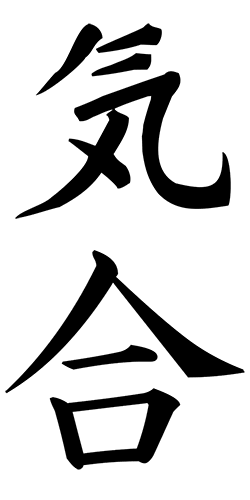 Kiai refers to the yell or shout made at the time of an attack. The kanji for kiai is made up of two characters. The first is “Ki”, meaning energy and the second is “Ai” which can be translated as “matching”, “meeting” or “uniting”.
Kiai refers to the yell or shout made at the time of an attack. The kanji for kiai is made up of two characters. The first is “Ki”, meaning energy and the second is “Ai” which can be translated as “matching”, “meeting” or “uniting”.
In kendo, kiai is an essential part of the strike. Ki-Ken-Tai-no-Ichi refers to the mind, sword and body being as one. Remembering that the strike in kendo is a metaphor for a killing or disabling blow, the metaphor is realized by the presence of ki-ken-tai.
To “see” ki-ken-tai-ichi” in action means three things have to happen simultaneously:
- The attacker must shout the name of her intended target.
- She must strike the intended target area with the proper part of her shinai
- Her foot must strike the ground.
Should one of these elements not be present or if they are not synchronized, then the strike is not valid. Developing one’s ki-ken-tai-ichi is fundamental to success in kendo. To develop one’s kiai is therefore essential.
Most cultures do not encourage yelling or shouting. It is one of the joys of kendo to be able to let loose with a blood-curdling scream. Interestingly, many students have to work on their ability to yell freely.
When students are new to kendo, kiai is one of the tougher things to get used to. One has to overcome resistance to yelling as well as getting used to yelling while physically exerting oneself. Most people don’t yell while jogging or cycling but in kendo one’s kiai for a strike starts at the moment of impact and then continues during the aftermath of the strike. This continued kiai takes effort to develop but is one of the many benefits kendo training has to offer.
Kiai in Keiko and Shiai
When sparring in practice or competition, you’ll often hear a lot of kiai without striking. In these instances, kiai can be used to express one’s own spirit and determination. One thing I find interesting to observe is how kiai varies among kendoka at different levels of experience. Students are often encouraged to kiai the moment they rise from sonkyo to express their spirit. Sometimes one kendoka expresses their kiai first and the second, not to be outdone, will kiai almost immediately afterward. When this happens, my perception is that the second kendoka is in a weaker position.
Responding to the first person’s kiai seems like a natural thing to do, but often the pattern is maintained during the match. This reminds me of a “call and response”. The first person challenges and the second responds. In this way, the first person is in control of the energy of the match. This is not because they are inherently better, but because the second person has subconsciously relinquished control by only responding to the first person’s kiai. From this perspesctive, it would be beneficial for the second person to withhold their kiai for a few moments, building their energy and releasing it at a more opportune moment.
As the title of this post states, these are just some musings about kiai. I welcome your opinions on the subject.
